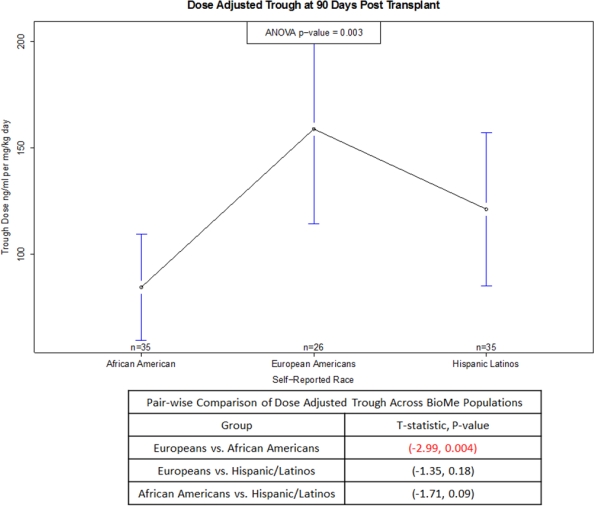Impact of Ethnicity on Tacrolimus Trough/Dose Ratios Following Solid Organ Transplantation.
Mount Sinai Hospital, New York.
Meeting: 2016 American Transplant Congress
Abstract number: B124
Keywords: Genomics, Immunosuppression, Monitoring
Session Information
Session Name: Poster Session B: Drug Minimization
Session Type: Poster Session
Date: Sunday, June 12, 2016
Session Time: 6:00pm-7:00pm
 Presentation Time: 6:00pm-7:00pm
Presentation Time: 6:00pm-7:00pm
Location: Halls C&D
Objective: to assess tacrolimus dosing requirements based upon ethnicity in order to help guide future decisions regarding dosage initiation and titration among Hispanic and African American transplant recipients.
Methods: patients were identified who had received tacrolimus, had ICD-9 codes for renal or cardiac transplantation, were transplanted between 01/2010 and 12/2014, and were at least 18 years of age. Participants were then grouped by ethnicity into African American (AA), Hispanic/Latino (HL), or Caucasian (CA) cohorts for data analysis. The primary data points evaluated in this study were tacrolimus trough/dose ratios at 7, 30, and 90 days post-transplant. Secondary endpoints included percentage of patients with therapeutic trough levels at 7, 30, and 90 days post-transplant as well as the number of patients switched from tacrolimus based immunosuppression.
Results: baseline characteristics were similar between the three ethnic cohorts with the exception of a higher proportion of cardiovascular transplants and larger baseline weight among Caucasians. Between group differences in weight-adjusted tacrolimus trough/dose ratios were statistically significant at both 30 as well as 90 days post-transplant. African Americans had the lowest weight-adjusted trough/dose ratios followed by Hispanic/Latinos and finally Caucasians  . African American patients also had the lowest percentage of therapeutic troughs at 7 days post-transplant; however, no differences were observed in the incidence of therapeutic trough levels at any other time period. Additionally, there appeared to be no differences in the requirement for change in immunosuppression based upon ethnicity at 7, 30, or 90 days post-transplant
. African American patients also had the lowest percentage of therapeutic troughs at 7 days post-transplant; however, no differences were observed in the incidence of therapeutic trough levels at any other time period. Additionally, there appeared to be no differences in the requirement for change in immunosuppression based upon ethnicity at 7, 30, or 90 days post-transplant
| Secondary Outcome | 7 Days Post Transplant | 30 Days Post Transplant | ||||
| AA | HL | CA | AA | HL | CA | |
| Therapeutic Troughs | 37.5% | 43.3% | 71.4% | 53.5% | 55.6% | 48.1% |
| Tacrolimus Discontinuation | 1 | 0 | 0 | 1 | 1 | 1 |
.
Conclusion: ethnic minorities have unique dosage considerations when prescribing tacrolimus based immunosuppression. These patient populations may also be under-dosed immediately following transplantation potentially leading to delays in the time to therapeutic tacrolimus trough levels.
CITATION INFORMATION: Santeusanio A, Owusu-Obeng A, Jeff J. Impact of Ethnicity on Tacrolimus Trough/Dose Ratios Following Solid Organ Transplantation. Am J Transplant. 2016;16 (suppl 3).
To cite this abstract in AMA style:
Santeusanio A, Owusu-Obeng A, Jeff J. Impact of Ethnicity on Tacrolimus Trough/Dose Ratios Following Solid Organ Transplantation. [abstract]. Am J Transplant. 2016; 16 (suppl 3). https://atcmeetingabstracts.com/abstract/impact-of-ethnicity-on-tacrolimus-troughdose-ratios-following-solid-organ-transplantation/. Accessed December 22, 2025.« Back to 2016 American Transplant Congress
